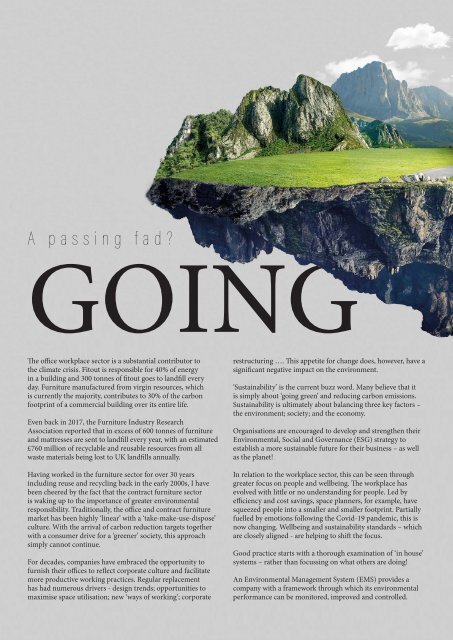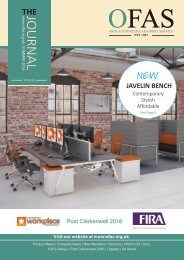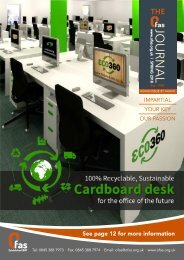CFAS Autumn 2021 Journal
Create successful ePaper yourself
Turn your PDF publications into a flip-book with our unique Google optimized e-Paper software.
Industry News and Services<br />
A passing fad?<br />
GOING<br />
The office workplace sector is a substantial contributor to<br />
the climate crisis. Fitout is responsible for 40% of energy<br />
in a building and 300 tonnes of fitout goes to landfill every<br />
day. Furniture manufactured from virgin resources, which<br />
is currently the majority, contributes to 30% of the carbon<br />
footprint of a commercial building over its entire life.<br />
Even back in 2017, the Furniture Industry Research<br />
Association reported that in excess of 600 tonnes of furniture<br />
and mattresses are sent to landfill every year, with an estimated<br />
£760 million of recyclable and reusable resources from all<br />
waste materials being lost to UK landfills annually.<br />
Having worked in the furniture sector for over 30 years<br />
including reuse and recycling back in the early 2000s, I have<br />
been cheered by the fact that the contract furniture sector<br />
is waking up to the importance of greater environmental<br />
responsibility. Traditionally, the office and contract furniture<br />
market has been highly ‘linear’ with a ‘take-make-use-dispose’<br />
culture. With the arrival of carbon reduction targets together<br />
with a consumer drive for a ‘greener’ society, this approach<br />
simply cannot continue.<br />
For decades, companies have embraced the opportunity to<br />
furnish their offices to reflect corporate culture and facilitate<br />
more productive working practices. Regular replacement<br />
has had numerous drivers - design trends; opportunities to<br />
maximise space utilisation; new ‘ways of working’; corporate<br />
restructuring …. This appetite for change does, however, have a<br />
significant negative impact on the environment.<br />
‘Sustainability’ is the current buzz word. Many believe that it<br />
is simply about ‘going green’ and reducing carbon emissions.<br />
Sustainability is ultimately about balancing three key factors –<br />
the environment; society; and the economy.<br />
Organisations are encouraged to develop and strengthen their<br />
Environmental, Social and Governance (ESG) strategy to<br />
establish a more sustainable future for their business – as well<br />
as the planet!<br />
In relation to the workplace sector, this can be seen through<br />
greater focus on people and wellbeing. The workplace has<br />
evolved with little or no understanding for people. Led by<br />
efficiency and cost savings, space planners, for example, have<br />
squeezed people into a smaller and smaller footprint. Partially<br />
fuelled by emotions following the Covid-19 pandemic, this is<br />
now changing. Wellbeing and sustainability standards – which<br />
are closely aligned - are helping to shift the focus.<br />
Good practice starts with a thorough examination of ‘in house’<br />
systems – rather than focussing on what others are doing!<br />
An Environmental Management System (EMS) provides a<br />
company with a framework through which its environmental<br />
performance can be monitored, improved and controlled.<br />
10 | www.cfas.uk

















